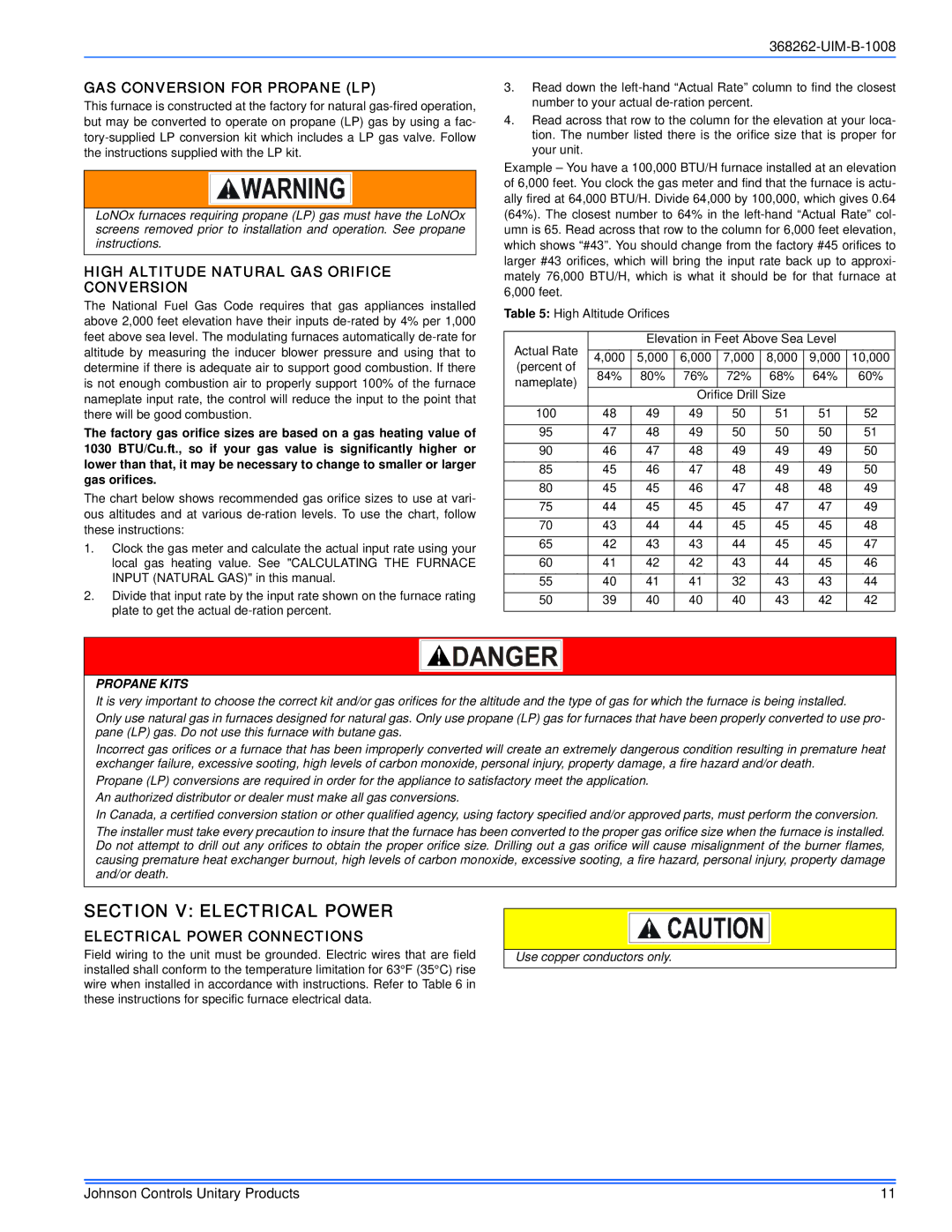
GAS CONVERSION FOR PROPANE (LP)
This furnace is constructed at the factory for natural
LoNOx furnaces requiring propane (LP) gas must have the LoNOx screens removed prior to installation and operation. See propane instructions.
HIGH ALTITUDE NATURAL GAS ORIFICE CONVERSION
The National Fuel Gas Code requires that gas appliances installed above 2,000 feet elevation have their inputs
The factory gas orifice sizes are based on a gas heating value of 1030 BTU/Cu.ft., so if your gas value is significantly higher or lower than that, it may be necessary to change to smaller or larger gas orifices.
The chart below shows recommended gas orifice sizes to use at vari- ous altitudes and at various
1.Clock the gas meter and calculate the actual input rate using your local gas heating value. See "CALCULATING THE FURNACE INPUT (NATURAL GAS)" in this manual.
2.Divide that input rate by the input rate shown on the furnace rating plate to get the actual
3.Read down the
4.Read across that row to the column for the elevation at your loca- tion. The number listed there is the orifice size that is proper for your unit.
Example – You have a 100,000 BTU/H furnace installed at an elevation of 6,000 feet. You clock the gas meter and find that the furnace is actu- ally fired at 64,000 BTU/H. Divide 64,000 by 100,000, which gives 0.64 (64%). The closest number to 64% in the
Table 5: High Altitude Orifices
Actual Rate |
| Elevation in Feet Above Sea Level |
| |||||
4,000 | 5,000 | 6,000 | 7,000 | 8,000 | 9,000 | 10,000 | ||
(percent of | ||||||||
84% | 80% | 76% | 72% | 68% | 64% | 60% | ||
nameplate) | ||||||||
|
|
| Orifice Drill Size |
|
| |||
100 | 48 | 49 | 49 | 50 | 51 | 51 | 52 | |
95 | 47 | 48 | 49 | 50 | 50 | 50 | 51 | |
90 | 46 | 47 | 48 | 49 | 49 | 49 | 50 | |
85 | 45 | 46 | 47 | 48 | 49 | 49 | 50 | |
80 | 45 | 45 | 46 | 47 | 48 | 48 | 49 | |
75 | 44 | 45 | 45 | 45 | 47 | 47 | 49 | |
70 | 43 | 44 | 44 | 45 | 45 | 45 | 48 | |
65 | 42 | 43 | 43 | 44 | 45 | 45 | 47 | |
60 | 41 | 42 | 42 | 43 | 44 | 45 | 46 | |
55 | 40 | 41 | 41 | 32 | 43 | 43 | 44 | |
50 | 39 | 40 | 40 | 40 | 43 | 42 | 42 | |
PROPANE KITS
It is very important to choose the correct kit and/or gas orifices for the altitude and the type of gas for which the furnace is being installed.
Only use natural gas in furnaces designed for natural gas. Only use propane (LP) gas for furnaces that have been properly converted to use pro- pane (LP) gas. Do not use this furnace with butane gas.
Incorrect gas orifices or a furnace that has been improperly converted will create an extremely dangerous condition resulting in premature heat exchanger failure, excessive sooting, high levels of carbon monoxide, personal injury, property damage, a fire hazard and/or death.
Propane (LP) conversions are required in order for the appliance to satisfactory meet the application. An authorized distributor or dealer must make all gas conversions.
In Canada, a certified conversion station or other qualified agency, using factory specified and/or approved parts, must perform the conversion.
The installer must take every precaution to insure that the furnace has been converted to the proper gas orifice size when the furnace is installed. Do not attempt to drill out any orifices to obtain the proper orifice size. Drilling out a gas orifice will cause misalignment of the burner flames, causing premature heat exchanger burnout, high levels of carbon monoxide, excessive sooting, a fire hazard, personal injury, property damage and/or death.
SECTION V: ELECTRICAL POWER
ELECTRICAL POWER CONNECTIONS
Field wiring to the unit must be grounded. Electric wires that are field installed shall conform to the temperature limitation for 63°F (35°C) rise wire when installed in accordance with instructions. Refer to Table 6 in these instructions for specific furnace electrical data.
Use copper conductors only.
Johnson Controls Unitary Products | 11 |
